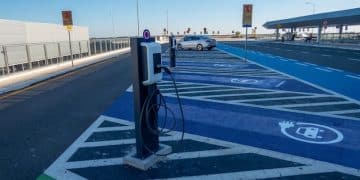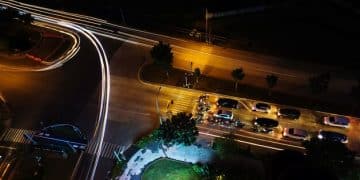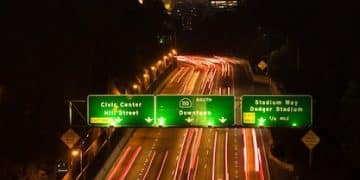Infrastructure Act’s Impact on US Transportation Tech: A Deep Dive

The Impact of the Infrastructure Investment and Jobs Act on US Transportation Technology is profoundly reshaping the sector through substantial investments in innovation, safety, and sustainability, setting the stage for a modernized and more efficient transportation system across the nation.
The Impact of the Infrastructure Investment and Jobs Act on US Transportation Technology is already being felt across the United States. This landmark legislation is not just about repairing roads and bridges; it’s a catalyst for innovation and modernization within the transportation sector.
Understanding the Infrastructure Investment and Jobs Act
The Infrastructure Investment and Jobs Act (IIJA), also known as the Bipartisan Infrastructure Law, represents a historic investment in America’s infrastructure. Its implications for transportation technology are far-reaching, promising to modernize and enhance the nation’s transportation systems.
Key Provisions of the IIJA Relevant to Transportation Technology
The IIJA allocates significant funding to various transportation-related projects and initiatives. A substantial portion of this funding is earmarked for advancements in transportation technology.
- Electric Vehicle (EV) Infrastructure: The Act provides billions of dollars for the development of a national network of EV chargers, aiming to accelerate the adoption of electric vehicles and reduce emissions.
- Public Transportation Modernization: Funds are allocated to upgrade and expand public transportation systems, including the integration of smart technologies for improved efficiency and accessibility.
- Smart Traffic Management: The IIJA supports the deployment of intelligent transportation systems (ITS) to optimize traffic flow, reduce congestion, and enhance safety.
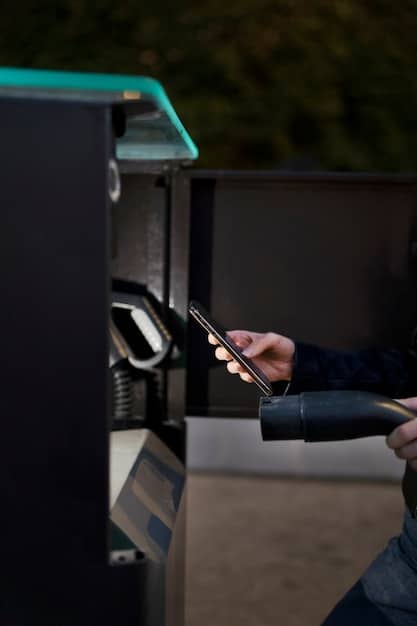
The IIJA’s focus extends beyond traditional infrastructure projects. It recognizes the pivotal role of technology in shaping the future of transportation, addressing urgent needs while fostering long-term innovation.
The Rise of Electric Vehicle Infrastructure
One of the most significant impacts of the IIJA is the acceleration of electric vehicle (EV) adoption through the development of a robust charging infrastructure. This investment is poised to transform the transportation landscape, making EVs a more viable option for consumers and businesses alike.
Expanding the National EV Charging Network
The IIJA allocates substantial funding to build a national network of EV chargers, with the goal of placing chargers every 50 miles along interstate highways. This initiative aims to alleviate range anxiety, a major barrier to EV adoption.
- Standardized Charging Protocols: Ensuring that chargers are compatible with various EV models through standardized charging protocols.
- Strategic Charger Placement: Placing chargers in convenient locations, such as rest stops, shopping centers, and workplaces, to encourage EV usage.
- Incentives for Private Investment: Providing incentives for private companies to invest in EV charging infrastructure, further accelerating the deployment of chargers.
With an improved nationwide charging infrastructure, the US Department of Transportation supports the widespread adoption of zero-emission vehicles (ZEV) to reduce emissions which will aid the goal of net-zero emissions by 2050.
Modernizing Public Transportation Systems
The IIJA is also driving the modernization of public transportation systems across the United States. Investing in public transportation allows more efficient travel as opposed to privately owned vehicles.
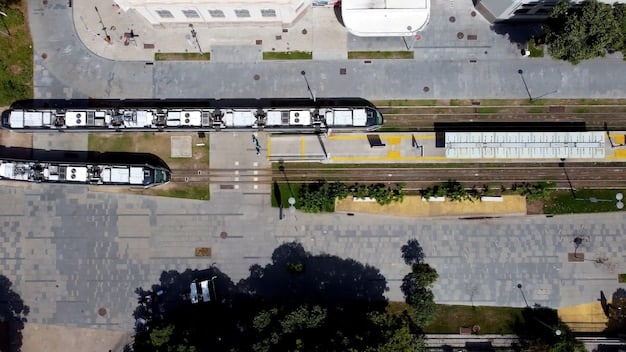
Innovations in Public Transit
The Act supports the integration of various technologies to enhance the efficiency and accessibility of public transportation.
- Real-Time Tracking Systems: Providing passengers with real-time information about bus and train schedules, arrival times, and potential delays.
- Contactless Payment Options: Implementing contactless payment systems to streamline fare collection and improve the passenger experience.
- Accessibility for People with Disabilities: Ensuring that public transportation systems are accessible to people with disabilities through features such as ramps, elevators, and audio-visual aids.
Ultimately, the plan is to make better investments in current infrastructure and add some technology. With many buses that are old and break down, these advancements would greatly encourage more people to use public transportation.
Improving Traffic Flow and Safety
The Bipartisan Infrastructure Law has many applications that revolve around increasing safety. By utilizing money from the act, US traffic systems will improve across America.
Applying Intelligent Transportation Systems
The IIJA supports the deployment of intelligent transportation systems (ITS) to optimize traffic flow, reduce congestion, and enhance safety on roadways.
By using ITS applications, our streets get an upgrade.
- Adaptive Traffic Signals: Adjusting traffic signal timing based on real-time traffic conditions to optimize traffic flow and reduce delays.
- Connected Vehicle Technology: Enabling vehicles to communicate with each other and with infrastructure, providing drivers with real-time information about potential hazards and traffic conditions.
- Automated Enforcement Systems: Using cameras and sensors to detect and deter speeding, red-light running, and other traffic violations.
In conclusion, better adaptive features in everyday transportation and increased safety will improve traffic flow and safety.
Cybersecurity in Transportation
The digital transformation of transportation systems also brings cybersecurity risks. The infrastructure law addresses these by investing in cybersecurity measures to protect transportation networks from cyberattacks.
Safeguarding Systems
With transportation systems becoming increasingly interconnected, it is all the more important to develop an organized security system in place.
- Threat Detection Systems: Monitoring systems for cyber threats and anomalies, providing early warning of potential attacks.
- Incident Response Plans: Developing comprehensive incident response plans to mitigate the impact of cyberattacks and recover quickly from disruptions.
- Cybersecurity Training for Transportation Professionals: Providing cybersecurity training for transportation professionals to raise awareness of cyber risks and promote best practices.
Cybersecurity is an ever growing threat and it will be important to develop defenses for our current and future infrastructure as well.
Challenges and Opportunities
While the IIJA presents numerous opportunities for advancing transportation technology, it also poses some challenges that need to be addressed. The law’s goal is to better America entirely, however, there are some issues that could prevent this.
Navigating Roadblocks
Successfully implementing the IIJA’s transportation technology initiatives requires careful planning, coordination, and execution. Some of the key challenges include:
- Workforce Development: Ensuring that there are enough skilled workers to design, build, and maintain the new transportation technologies.
- Regulatory Framework: Developing a clear and consistent regulatory framework to govern the deployment of new transportation technologies.
- Public Acceptance: Gaining public support for new transportation technologies by addressing concerns about safety, privacy, and equity.
However, the hope remains that America will improve as a whole by utilizing these upgrades. By addressing these issues and building modern infrastructure, the United States will greatly improve transportation.
| Key Area | Brief Description |
|---|---|
| ⚡ EV Infrastructure | Significant investment in building a national network of electric vehicle chargers. |
| 🚈 Public Transit | Modernizing public transportation systems, including real-time tracking and contactless payments. |
| 🚦 Traffic Management | Deploying intelligent transportation systems to improve traffic flow and safety. |
| 🔒 Cybersecurity | Strengthening cybersecurity measures to protect transportation networks from cyber threats. |
FAQ
▼
The Infrastructure Investment and Jobs Act (IIJA) is a federal law enacted to improve and expand the United States’ infrastructure, including transportation systems, broadband internet access, and utilities.
▼
The IIJA allocates billions of dollars to create a national network of EV charging stations, promoting electric vehicle adoption by addressing range anxiety and improving charging accessibility across the country.
▼
The IIJA funds modernization efforts in public transportation, integrating technologies such as real-time tracking systems, contactless payments, and enhanced accessibility features, thus improving the passenger experience.
▼
The IIJA supports the use of intelligent transportation systems (ITS) like adaptive traffic signals and connected vehicle technology to optimize traffic flow, reduce congestion, and offer real-time hazard information to drivers.
▼
As transportation systems become more digitally connected, the IIJA invests in cybersecurity measures to protect these networks from cyberattacks, ensuring safer operations and protecting critical infrastructure.
Conclusion
In summation, the Impact of the Infrastructure Investment and Jobs Act on US Transportation Technology is expected to be both profound and transformative, driving innovation, improving safety, and promoting sustainability across the nation’s transportation systems. In the coming years, these investments will certainly reshape the US for the better.


